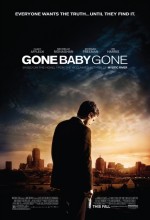2007 // USA // Tamara Jenkins // January 3, 2008 // Theatrical Print
C - The Savages is, if nothing else, unequivocal in its subject matter. It tackles the admittedly tricky topic of elderly dementia with gusto, exhibiting fearless interest in how such a tragedy can act as a catalyst and a stressor on toxic familial dynamics. The route it takes to this destination is muddled, however. Tamara Jenkins aspires for her second feature film to be both funny and touching, and to that end she traffics simultaneously in affected oddness, excruciating awkwardness, and legitimate human pain. The mixture never quite coagulates into anything particularly revelatory or even into lasting amusement. It's a credit to Jenkins' sharp dialog and the talent of her lead performers, therefore, that The Savages manages to find some absorbing drama in the deepest corners of the black comedy coal bin.
Laura Linney is Wendy Savage, a middle-age office temp and wannabe playwright. Linney has a somewhat inflexible approach to her acting, but she's always mesmerizing to watch, and no less so in The Savages. Wendy is probably the most repulsive character she has ever played, and it's a harsh spectacle to witness, given that age has bestowed me with a tendency for celebrity crushes on older, skillful actresses like Linney. Wendy lies compulsively, often to elicit envy or pity. She steals stacks of office supplies from work, sleeps with a married man, and self-consciously frets that her unproduced plays are too whiny and indulgent. She also clearly hates herself.
Philip Seymour Hoffman is Jon Savage, Wendy's older brother and a professor of drama. Less repugnant but more pathetic than his sibling, Jon is trapped in author's purgatory with an unfinished Bertolt Brecht book looming over him. Hoffman approaches the role with his now-familiar naturalistic style. As the rumpled Jon, he is full of mumbles, long sighs, and thousand-yard stares. He seems to have a significant intellect, but he's so damn lethargic, any scruffy endearment he might have had has long been strangled. He can't even work up the fortitude to marry his Polish girlfriend, despite the fact that her departure—due to an expiring visa—causes him obvious agony.
Given these middle-aged middle-class losers, wouldn't you know there's an unpleasant family history? Wendy and Jon rarely speak to each other, and they never speak to their father, Lenny, now living in Arizona with his ailing girlfriend. When the elder Savage begins descending into dementia, the brother and sister must retrieve him and find him a nursing home. Philip Bosco plays Lenny with alternating volcanic agitation and forlorn distraction, a believable performance that somehow maintains the focus on Wendy and Jon. And, indeed, The Savages is less about Lenny than about how his condition scratches his children's scars until they are raw and bleeding.
Jenkins approaches the drama of these uncomfortable circumstances with admirably stifling realism. She doesn't shy away from the sheer terrible fact of dementia, and she has a good sense for the wretched, absurd nature of its effects. I lost each of my grandfathers to Alzheimer's disease and a Parkinson-plus syndrome, respectively, and The Savages' bleakness struck me as painfully authentic. In one of the film's darkest, slickest moments, Hoffman launches into an arrogant, screaming monologue about the nursing home industry's predatory aim to distract clients from the "horror-show" of aging with group activities and landscaping. Indeed.
Where The Savages falters is in its attempts to inject levity by means of deliberate eccentricity. This tactic is not inherently flawed. Juno, to offer a counterexample, employs slanted characterization and production design to great effect, blending them into an attractive and neatly executed comic whole. In contrast, Jenkins dribbles goofy details into The Savages without much consequence or sense. When Wendy and Jon arrive in Arizona to fetch their father, they inexplicably bring a gaudy, heart-shaped Mylar balloon. Nothing in Wendy or Jon's character suggests this dash of kitsch. Its presence seems due to Jenkins' desire to giggle at the indignity in husky, sulky Hoffman holding onto it. A similar dynamic plagues the broader narrative. When Lenny selects a racist silent film for movie night at his overwhelmingly black-staffed nursing home, the results are awkward, but also flimsy. The scene is unmoored from the rest of the film, and not particularly funny.
The Savages is at its wittiest when the ugliness of Lenny's condition or Wendy and Jon's personalities becomes so pronounced that the film ventures into farce. In other words, its funniest scenes are those that are the least deliberately funny. There's a weird, visceral thrill in watching two gifted actors like Linney and Hoffman bicker, and some intriguing themes ooze through their characters' neuroses. I don't know that the film will hold up well on a second viewing, but Jenkins' script is at its strongest in these moments, suggesting that a superior The Savages might lie in a two-person stage play.
There's enough gleam in the best features of The Savages to recommend it, particularly if you like your comedy pitch-black. It's an acidic pleasure to see Linney and Hoffman play characters like Wendy and Jon, and Jenkins is adept at crafting dialogue and subtly tugging her performers in the right directions. Unfortunately, she cobbles The Savages together without much discipline or significance, such that the result is ultimately aimless. That's a shame. The Savages has an unsentimental view of aging and family that, unlike many comedies about damaged people and awful events, is both caustic and genuine.









